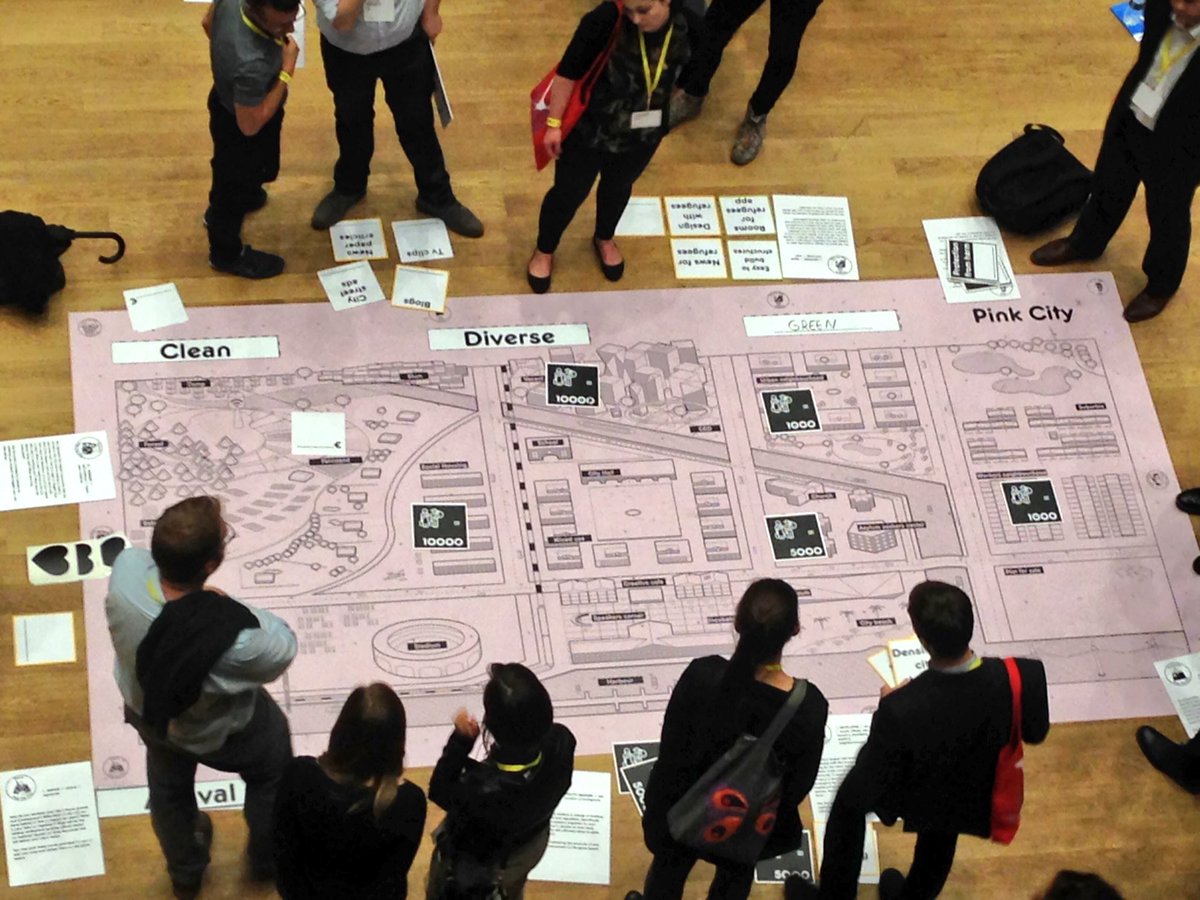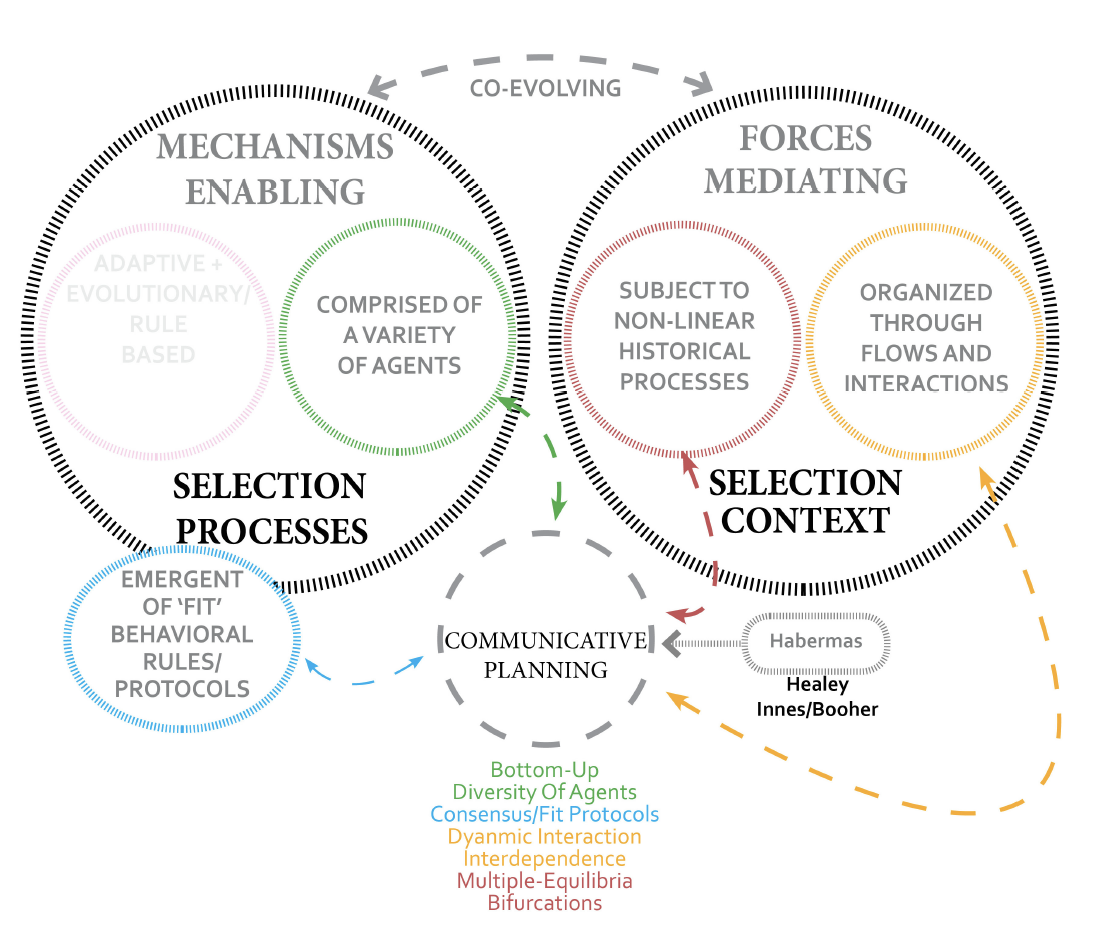cas/taxonomy/field.php (field)

Communicative Planning
Communicative planning broadens the scope of voices engaged in planning processes. How does complexity help us understand the productive capacity of these diverse agents?
A growing number of spatial planners are realizing that they need to harness many voices in order to navigate the complexities of the planning process. Communicative strategies aim to move from a top-down approach of planning, to one that engages many voices from the bottom up.
Backdrop
Communicative planning is a specific strategic approach to developing plans in cooperation with a broader range of actors. If master plans relied on the expertise of the top-down planner, then communicative approaches aim to broaden the number of voices engaged in the process, include more perspectives, and garner more wisdom from harnessing the bottom-up "wisdom of crowds".
Here, planning is positioned as being a "wicked problem": one with poor boundaries, many diverging and overlapping concerns, and no direct pathway for problem "solutions". It is therefore seen as a problem in "complexity" - the term largely adopted so as to refer to the messiness of the problem domain. In this reading, agents in the system are considered as individual stake-holders, each of which have personal interests that need to be resolved or addressed. At issue is how best to 'strategically navigate' amongst these players, so that an "emergent" solution can be reached.
Within this reading, it is helpful to consider the differential power that each stakeholder wields, so as to better balance dynamics that might lead to unfair planning solutions. Such situations arise, for example when a particular party (such as a developer), holds inequitable resources available to influence planning decision-making. Accordingly communicative planners try to understand the relative flows of agency available within the process, and then channel these in more equitable, balanced ways.
Relation to Complexity
Planners with these interests are often drawn to principles from complexity, not least because of the fact that one of the key thinkers in the domain Patsy Healey, has a seminal book, the title of which is "Urban Complexity and Spatial Strategies". The approach, does indeed, relate to complexity in that it emphasis a bottom-up approach, by which a consensual strategy for planning emerges. Here, the use of the word "complexity" may be more metaphorical then technical (if we assume that in this context it is simply suggesting that planning is 'complicated'). Similarly, there are other aspects of complexity theory that are appropriated in this discourse, some in more direct, others in more metaphorical manners.
Networks
Communicative Planners have a strong interest in how the nature of the actor Networks affect how decision-making takes place (and whose voices dominate the network). There is a strong link between Communicative approaches and Actor Network Theory (or ANT), which examines network dynamics as what ultimately constitutes certain forms or protocols previously accepted as 'givens'. Here, similar to the approach of relational geography, we see that the relations constituting a given entity are being more fundamental than the entities themselves.
Agents
Part of the objectives of Network analysis are to understand what nodes in the network hold more power, tracing which agents in the system play a larger causal role in driving it forward. Communicative Planners, consider how Bottom-up Agents, in the form of diverse stake-holders steer the process, and where differences in agency lie. While consensus can "emerge" from many kinds of bottom-up agents interactions, such emergence can be subject to inequitable steering depending on how stakeholders are empowered or disempowered in the process. The concern for agents here is thus less about "rule-based" decision making, or how such agents adapt, but moreso about how so-called bottom-up dynamics need to be facilitated so as to ensure that the meaningful input of all agents can be garnered in discovering a planning solution. The concern is that some processes leave agents out - unable to contribute to the emergent characteristics of a given planning strategy.
Emergence
For communicative planners, the concept of emergence is again used more as a metaphorical tool than in a technical manner. To illustrate: even though diverse ants in a complex system form an emergent trail, they do not do so by sitting around together in a colony deliberating and weighing which course of action to take. Emergence in the more technical sense relates to actions that are performed in an environment, where the agents involved - be it sand grains or ants - need not be consciously cooperating. By the same token, ants need not compromise their own needs on the part of the colony. This is not to say that the communicative approach towards emergent consensus is not of value, only that it is probably not of the same kind as what we would see in natural complex systems.
That said, the language and terms drawn from complexity seem to offer communicative planners with a useful set of concepts: able to convey something meaningful about developing a more contingent, more open-ended, more bottom-up approach and more relational approach to decision making.

Back to Complexity & Urbanism
Back to Navigating Complexity
Photo Credit and Caption: Play the City
Cite this page:
Wohl, S. (2022, 13 June). Communicative Planning. Retrieved from https://kapalicarsi.wittmeyer.io/taxonomy/communicativestrategic-navigation
Communicative Planning was updated June 13th, 2022.
Nothing over here yet
This is the feed, a series of related links and resources. Add a link to the feed →
This is a list of People that Communicative Planning is related to.
Communicative Planning
Patsey Healey has provided a significant contribution to discussions regarding communicative planning and complex systems.
Learn more →Strategic Planning
This is a default subtitle for this page. Learn more →This is a list of Terms that Communicative Planning is related to.
The quantity and breadth of a system's adaptive potential is its 'requisite variety'.
In order for a complex system to adapt, it needs to contain agents that have the capacity to behave in different ways - to enact adaptation you need adaptable things. Learn more →This is a list of Urban Fields that Communicative Planning is related to.
Communicative planning broadens the scope of voices engaged in planning processes. How does complexity help us understand the productive capacity of these diverse agents?
A growing number of spatial planners are realizing that they need to harness many voices in order to navigate the complexities of the planning process. Communicative strategies aim to move from a top-down approach of planning, to one that engages many voices from the bottom up.
This is a list of Key Concepts that Communicative Planning is related to.
Network theory allows us think about how the dynamics of agent interactions in a complex system can affect the performance of that system.
Network theory is a huge topic in and of itself, and can be looked at on its own, or in relation to complex systems. There are various formal, mathematical ways of studying networks, as well as looser, more fluid ways of understanding how networks can serve as a structuring mechanism. Learn more →
Navigating Complexity © 2015-2025 Sharon Wohl, all rights reserved. Developed by Sean Wittmeyer
Sign In (SSO) | Sign In
Related (this page): Emergence (24), Driving Flows (25), Communicative Planning (18), Bottom-up Agents (22), TUTORIAL: Algorithms & Differentials (61), Patsy Healey (137), Networks (75), Information (73),
Section: fields
Non-Linearity Related (same section): Urban Modeling (11, fields), Resilient Urbanism (14, fields), Relational Geography (19, fields), Landscape Urbanism (15, fields), Evolutionary Geography (12, fields), Communicative Planning (18, fields), Assemblage Geography (20, fields), Related (all): Tipping Points (218, concepts), Path Dependency (93, concepts), Far From Equilibrium (212, concepts),
Nested Orders Related (same section): Urban Modeling (11, fields), Urban Informalities (16, fields), Resilient Urbanism (14, fields), Related (all): Self-Organized Criticality (64, concepts), Scale-Free (217, concepts), Power Laws (66, concepts),
Emergence Related (same section): Urban Modeling (11, fields), Urban Informalities (16, fields), Urban Datascapes (28, fields), Incremental Urbanism (13, fields), Evolutionary Geography (12, fields), Communicative Planning (18, fields), Assemblage Geography (20, fields), Related (all): Self-Organization (214, concepts), Fitness (59, concepts), Attractor States (72, concepts),
Driving Flows Related (same section): Urban Datascapes (28, fields), Tactical Urbanism (17, fields), Relational Geography (19, fields), Parametric Urbanism (10, fields), Landscape Urbanism (15, fields), Evolutionary Geography (12, fields), Communicative Planning (18, fields), Assemblage Geography (20, fields), Related (all): Open / Dissipative (84, concepts), Networks (75, concepts), Information (73, concepts),
Bottom-up Agents Related (same section): Urban Modeling (11, fields), Urban Informalities (16, fields), Resilient Urbanism (14, fields), Parametric Urbanism (10, fields), Incremental Urbanism (13, fields), Evolutionary Geography (12, fields), Communicative Planning (18, fields), Related (all): Rules (213, concepts), Iterations (56, concepts),
Adaptive Capacity Related (same section): Urban Modeling (11, fields), Urban Informalities (16, fields), Tactical Urbanism (17, fields), Parametric Urbanism (10, fields), Landscape Urbanism (15, fields), Incremental Urbanism (13, fields), Evolutionary Geography (12, fields), Related (all): Feedback (88, concepts), Degrees of Freedom (78, concepts),
